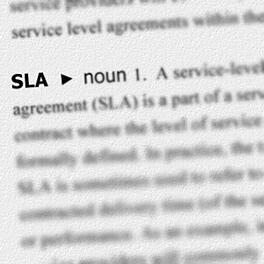A Service Level Agreement – commonly abbreviated to SLA – is a vital part of any service contract. It formally defines the minimum level of service a customer requires from their provider. Service Level Agreements are very common across a number of industries; for example, you are likely to have an SLA with your internet service provider outlining the performance levels they must meet.
 In the event they fall short of the minimum service levels, you have the power to seek damages or compensation. The SLA is more than just a contract – it’s also a process. In this instance the course of redress should be specified and the appropriate action should be taken.
In the event they fall short of the minimum service levels, you have the power to seek damages or compensation. The SLA is more than just a contract – it’s also a process. In this instance the course of redress should be specified and the appropriate action should be taken.
SLAs are common in the Software-as-a-Service delivery model of IT resources for obvious reasons. When you rely on a third party for IT capabilities via a web browser, you trust them with some of your key business functions. You need to safeguard elements like the minimum level of service uptime, and ensure the service does what it is supposed to do. Having this formalised in writing is a necessary step.
An effective SLA measures performance targets so that any discrepancies can be worked through and resolved without any fuss.
Who benefits from a Service Level Agreement?
You may think that SLAs only benefit the customer and not the service provider. But you’d be wrong. SLAs offer a number of benefits to both parties including:
- Delivering clear performance expectations of both the customer and provider.
- Cementing the roles and responsibilities of each party.
- Drawing attention to customers’ priority needs.
- Promoting a service quality culture and driving improvement.
- Creating a checklist for both parties to plan for the future.
- Giving the customer purchasing power.
- Allowing the customer a simple way to monitor performance.
- Giving the service provider incentive to innovate.
- Being key points of differentiation to distinguish between competitors.
The final point in the list of benefits is particularly important for cloud providers. Whilst customers have the power to decide which companies meet their minimum service requirements, providers can use their levels of guaranteed performance to communicate trust in their ability to deliver and prove that their service is effective.
MailGuard, for example offers 100% service uptime and 100% email delivery as standard.
What should an SLA consist of?
The SLA should define clear and measurable terms in plain English. Service levels should be defined, as should the process to be followed by both parties, in the event they are not met.
Keep up to date on the very latest industry news
Follow MailGuard's blog where you can register to receive weekly email updates, or by following us on social media.







